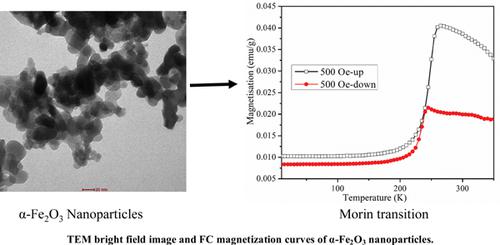Current Nanoscience ( IF 1.4 ) Pub Date : 2020-11-30 , DOI: 10.2174/1573413716666191223124722 Ihab M. Obaidat 1 , Sulaiman Alaabed 2 , Imad A. Al-Omari 3 , Venkatesha Narayanaswamy 2 , Bashar Issa 4 , Abbas Khaleel 5

|
Background: In nano-size α-Fe2O3 particles, the Morin transition temperature was reported to be suppressed. This suppression of the TM in nano-size α-Fe2O3 was suggested to be due to high internal strain and to the enhanced role of surface spins because of the enhanced surface to volume ratio. It was reported that for nanoparticles of diameters less than 20 nm, no Morin transition was observed and the antiferromagnetic phase disappears. In addition, annealing of samples was reported to result in both an increase of TM and a sharper transition which were attributed to the reduction in defects, crystal growth, or both.
Objective: In this work, we investigated the role of applied magnetic field in TM, the extent of the Morin transition, thermal hysteresis, and the spin-flop field in synthetic α-Fe2O3 nanoparticles of diameter around 20 nm.
Methods: Hematite nanoparticles were synthesized using the sol-gel method. Morphology and structural studies of the particles were done using TEM, and XRD, respectively. The XRD patterns confirm that the particles are hematite with a very small maghemite phase. The average size of the nanoparticles is estimated from both TEM images and XRD patterns to be around 20 nm. The magnetization versus temperature measurements were conducted upon heating from 5 K to 400 K and cooling down back to 5 K at several applied fields between 50 Oe and 500 Oe. Magnetization versus magnetic field measurements between -5 T and +5 T were conducted at several temperatures in the temperature range of 2-300 K.
Results: We report three significant findings in these hematite nanoparticles. Firstly, we report the occurrence of Morin transition in hematite nanoparticles of such size. Secondly, we report the slight field dependence of Morin transition temperature. Thirdly, we report the strong temperature dependence of the spin-flop. Zero-field-cooled magnetization versus temperature measurements were conducted at several applied magnetic fields.
Conclusion: From the magnetization versus temperature curves, Morin transition was observed to occur in all applied fields at Morin transition temperature, TM which is around 250 K with slight field dependence. From the magnetization versus magnetic field curves, spin-flop in the antiferromagnetic state was observed and found to be strongly temperature dependent. The results are discussed in terms of three components of the magnetic phase in our sample. These are the paramagnetic, soft ferromagnetic, and hard ferromagnetic components.
中文翻译:

合成赤铁矿纳米粒子中场依赖的Morin跃迁和温度依赖的旋转触发器
背景:在纳米尺寸的α-Fe 2 ö 3颗粒,报道了Morin转换温度被抑制。在纳米尺寸的α-Fe的TM的这种抑制2 ö 3建议是由于高的内部应变和表面的作用增强自旋因为增强的表面与体积比的。据报道,对于直径小于20nm的纳米颗粒,没有观察到莫林跃迁并且反铁磁相消失。另外,据报道,样品的退火导致TM的增加和更陡峭的转变,这归因于缺陷的减少,晶体生长或两者兼而有之。
目标:在本工作中,我们调查施加的磁场在TM中,Morin转换,热滞后的程度的作用,和在合成的α-Fe自旋触发器字段2 ö 3约20nm直径的纳米颗粒。
方法:采用溶胶-凝胶法合成赤铁矿纳米粒子。颗粒的形态和结构研究分别使用TEM和XRD进行。XRD图谱证实颗粒是赤铁矿,具有非常小的磁赤铁矿相。从TEM图像和XRD图样估计纳米颗粒的平均尺寸为约20nm。在从5 K加热到400 K并在50 Oe和500 Oe之间的多个施加磁场下冷却回5 K时进行磁化强度与温度的测量。在2-300 K的温度范围内的几个温度下进行了介于-5 T和+5 T之间的磁化与磁场测量。
结果:我们报告了这些赤铁矿纳米颗粒的三个重要发现。首先,我们报道了在这种尺寸的赤铁矿纳米粒子中发生莫林转变的现象。其次,我们报道了莫林转变温度的场依赖性。第三,我们报告了旋转触发器对温度的强烈依赖性。在几个外加磁场下进行了零场冷却的磁化强度与温度的关系测量。
结论:从磁化强度与温度的关系曲线可以看出,在莫林转变温度TM大约为250 K时,在所有施加的磁场中都发生了莫林转变。从磁化强度与磁场的关系曲线,可以观察到反铁磁态的自旋触发器与温度密切相关。根据样品中磁性相的三个成分讨论了结果。这些是顺磁性,软铁磁性和硬铁磁性成分。











































 京公网安备 11010802027423号
京公网安备 11010802027423号